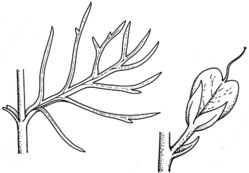Veronica nivea Lindl. APNI* Synonyms: Derwentia nivea (Lindl.) B.G.Briggs & Ehrend. APNI*
Parahebe sp. C sensu Jacobs & Pickard (1981) APNI*

Description: Softly woody shrub, with stems erect or ascending, 15–50 cm long, often appearing unbranched but most nodes bearing very short lateral branches with compact clusters of leaves, stems usually dying back to base after fruiting, internodes with sparse curved or twisted hairs in longitudinal bands.
Leaves usually 1.5–3 cm long, ± glabrous, pinnately divided into 2–17 linear lobes, longest lobes 3–20 mm long and often further divided or toothed, ultimate divisions 0.5–1.2 mm wide, subacute.
Racemes mostly 5–17 cm long, 20–40-flowered. Calyx lobes 2–5 mm long and 1–1.5 mm wide in fruit, glabrous or sparsely hairy near base. Corolla 3.5–6 mm long, white or pale lilac or bright blue.
Capsule broad-obovate, 4–6.5 mm long and almost as broad, deeply emarginate, strongly compressed, glabrous, glossy.
Flowering: Summer.
Distribution and occurrence: Grows in alpine and subalpine grassland, heath, bogs, and in subalpine woodland of Kosciusko area, mostly 1500-2000 m alt.
NSW subdivisions: ST
Other Australian states: Vic. Tas.
Text by B. G. Briggs & R. O. Makinson
Taxon concept: as under Derwentia nivea in Flora of NSW 3 (1992)
APNI* Provides a link to the Australian Plant Name Index (hosted by the Australian National Botanic Gardens) for comprehensive bibliographic data
***The AVH map option provides a detailed interactive Australia wide distribution map drawn from collections held by all major Australian herbaria participating in the Australian Virtual Herbarium project.
|


